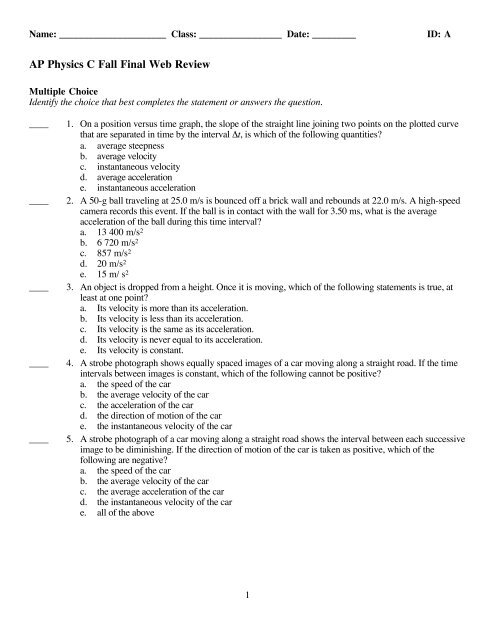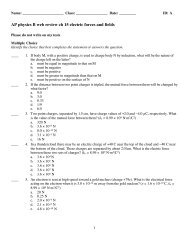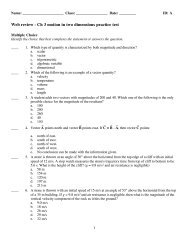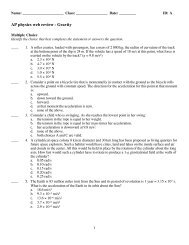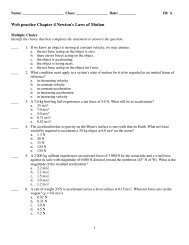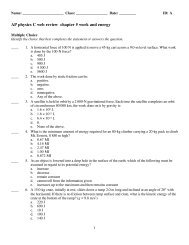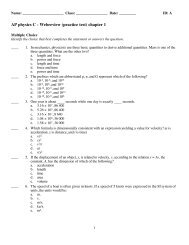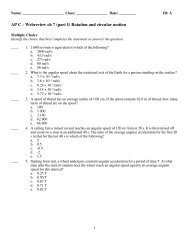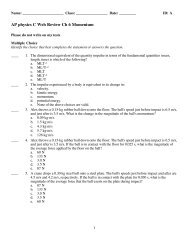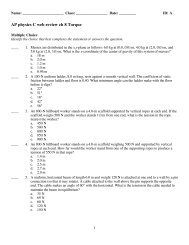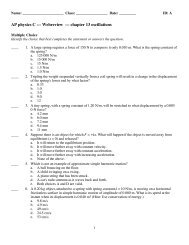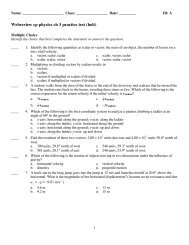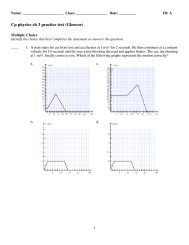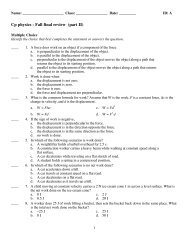AP Physics C Fall Final Web Review
AP Physics C Fall Final Web Review - Planet Holloway
AP Physics C Fall Final Web Review - Planet Holloway
- No tags were found...
You also want an ePaper? Increase the reach of your titles
YUMPU automatically turns print PDFs into web optimized ePapers that Google loves.
Name: ______________________ Class: _________________ Date: _________<br />
ID: A<br />
<strong>AP</strong> <strong>Physics</strong> C <strong>Fall</strong> <strong>Final</strong> <strong>Web</strong> <strong>Review</strong><br />
Multiple Choice<br />
Identify the choice that best completes the statement or answers the question.<br />
____<br />
____<br />
____<br />
____<br />
____<br />
1. On a position versus time graph, the slope of the straight line joining two points on the plotted curve<br />
that are separated in time by the interval Δt, is which of the following quantities?<br />
a. average steepness<br />
b. average velocity<br />
c. instantaneous velocity<br />
d. average acceleration<br />
e. instantaneous acceleration<br />
2. A 50-g ball traveling at 25.0 m/s is bounced off a brick wall and rebounds at 22.0 m/s. A high-speed<br />
camera records this event. If the ball is in contact with the wall for 3.50 ms, what is the average<br />
acceleration of the ball during this time interval?<br />
a. 13 400 m/s 2<br />
b. 6 720 m/s 2<br />
c. 857 m/s 2<br />
d. 20 m/s 2<br />
e. 15 m/ s 2<br />
3. An object is dropped from a height. Once it is moving, which of the following statements is true, at<br />
least at one point?<br />
a. Its velocity is more than its acceleration.<br />
b. Its velocity is less than its acceleration.<br />
c. Its velocity is the same as its acceleration.<br />
d. Its velocity is never equal to its acceleration.<br />
e. Its velocity is constant.<br />
4. A strobe photograph shows equally spaced images of a car moving along a straight road. If the time<br />
intervals between images is constant, which of the following cannot be positive?<br />
a. the speed of the car<br />
b. the average velocity of the car<br />
c. the acceleration of the car<br />
d. the direction of motion of the car<br />
e. the instantaneous velocity of the car<br />
5. A strobe photograph of a car moving along a straight road shows the interval between each successive<br />
image to be diminishing. If the direction of motion of the car is taken as positive, which of the<br />
following are negative?<br />
a. the speed of the car<br />
b. the average velocity of the car<br />
c. the average acceleration of the car<br />
d. the instantaneous velocity of the car<br />
e. all of the above<br />
1
Name: ______________________<br />
ID: A<br />
____<br />
____<br />
____<br />
____<br />
____<br />
____<br />
6. A ball is pushed with an initial velocity of 4.0 m/s. The ball rolls down a hill with a constant<br />
acceleration of 1.6 m/s 2 . The ball reaches the bottom of the hill in 8.0 s. What is the ball's velocity at<br />
the bottom of the hill?<br />
a. 10 m/s<br />
b. 12 m/s<br />
c. 16 m/s<br />
d. 17 m/s<br />
e. 19 m/s<br />
7. A bird, accelerating from rest at a constant rate, experiences a displacement of 28 m in 11 s. What is<br />
the final velocity after 11 s?<br />
a. 1.8 m/s<br />
b. 3.2 m/s<br />
c. 5.1 m/s<br />
d. 6.7 m/s<br />
e. zero<br />
8. If the displacement of an object is given in SI units by Δx = -3 t + 4 t 2 , at t = 2 s its velocity and<br />
acceleration are, respectively:<br />
a. positive, positive.<br />
b. positive, negative.<br />
c. negative, negative.<br />
d. negative, positive.<br />
e. negative, zero.<br />
9. In the case of constant acceleration, the average velocity equals the instantaneous velocity:<br />
a. at the beginning of the time interval.<br />
b. at the end of the time interval.<br />
c. half-way through the time interval.<br />
d. three-fourths of the way through the time interval.<br />
e. one-fourth of the way through the time interval.<br />
10. A rock is thrown straight down with an initial velocity of 14.5 m/s from a cliff. What is the rock's<br />
displacement after 2.0 s? (Acceleration due to gravity is 9.80 m/s 2 .)<br />
a. 28 m<br />
b. 49 m<br />
c. 55 m<br />
d. 64 m<br />
e. 72 m<br />
11. A rock is thrown straight up with an initial velocity of 24.5 m/s. What maximum height will the rock<br />
reach before starting to fall downward? (Take acceleration due to gravity as 9.80 m/s 2 .)<br />
a. 9.80 m<br />
b. 19.6 m<br />
c. 24.5 m<br />
d. 30.6 m<br />
e. 35.3 m<br />
2
Name: ______________________<br />
ID: A<br />
____<br />
____<br />
____<br />
____<br />
____<br />
____<br />
12. A hiker walks 200 m west and then walks 100 m north. In what direction is her resulting<br />
displacement?<br />
a. north<br />
b. west<br />
c. northwest<br />
d. east<br />
e. None of the answers is correct.<br />
13. Arvin the Ant is on a picnic table. He travels 30 cm eastward, then 25 cm northward, and finally 15 cm<br />
westward. What is the magnitude of Arvin's net displacement?<br />
a. 70 cm<br />
b. 57 cm<br />
c. 52 cm<br />
d. 29 cm<br />
e. 18 cm<br />
14. A jogger runs halfway around a circular path with a radius of 60 m. What, respectively, are the<br />
magnitude of the displacement and the distance jogged?<br />
a. 60 m, 188 m<br />
b. 120 m, 188 m<br />
c. 0 m, 377 m<br />
d. 120 m, 377 m<br />
e. 60 m, 377 m<br />
15. John throws a baseball from the outfield from shoulder height, at an initial velocity of 29.4 m/s at an<br />
initial angle of 30.0° with respect to the horizontal. The ball is in its trajectory for a total interval of<br />
3.00 s before the third baseman catches it at an equal shoulder-height level. (Assume air resistance<br />
negligible.) What is the ball's horizontal displacement?<br />
a. 76.4 m<br />
b. 38.2 m<br />
c. 57.3 m<br />
d. 66.7 m<br />
e. zero<br />
16. A baseball thrown from the outfield is released from shoulder height at an initial velocity of 29.4 m/s<br />
at an initial angle of 30.0° with respect to the horizontal. If it is in its trajectory for a total of 3.00 s<br />
before being caught by the third baseman at an equal shoulder-height level, what is the ball's net<br />
vertical displacement during its 3-s trajectory?<br />
a. 11.0 m<br />
b. 9.80 m<br />
c. 22.1 m<br />
d. zero<br />
e. 44.1 m<br />
17. A ball is rolled horizontally off a table with an initial speed of 0.24 m/s. A stop watch measures the<br />
ball's trajectory time from table to the floor to be 0.30 s. How far away from the table does the ball<br />
land? (g = 9.8 m/s 2 and air resistance is negligible)<br />
a. 0.055 m<br />
b. 0.072 m<br />
c. 1.2 m<br />
d. 1.9 m<br />
e. 2.5 m<br />
3
Name: ______________________<br />
ID: A<br />
____ 18. A stone is thrown at an angle of 30° above the horizontal from the top edge of a cliff with an initial<br />
speed of 12 m/s. A stop watch measures the stone's trajectory time from top of cliff to bottom to be<br />
5.6 s. What is the height of the cliff? (g = 9.8 m/s 2 and air resistance is negligible)<br />
a. 58 m<br />
b. 154 m<br />
c. 120 m<br />
d. 197 m<br />
e. 213 m<br />
____ 19. A stone is thrown at an angle of 30° above the horizontal from the top edge of a cliff with an initial<br />
speed of 12 m/s. A stop watch measures the stone's trajectory time from top of cliff to bottom to be<br />
5.6 s. How far out from the cliff's edge does the stone travel horizontally? (g = 9.8 m/s 2 and air<br />
resistance is negligible)<br />
a. 58 m<br />
b. 154 m<br />
c. 120 m<br />
d. 175 m<br />
e. 197 m<br />
____ 20. Two ropes are attached to a 40-kg object. The first rope applies a force of 25 N and the second, 40 N.<br />
If the two ropes are perpendicular to each other, what is the resultant acceleration of the object?<br />
a. 1.2 m/s 2<br />
b. 3.0 m/s 2<br />
c. 5.0 m/ s 2<br />
d. 25 m/s 2<br />
e. 47 m/s 2<br />
____ 21. The acceleration due to gravity on the Moon's surface is one-sixth that on Earth. What net force<br />
would be required to accelerate a 20-kg object at 6.0 m/s 2 on the moon?<br />
a. 1.3 N<br />
b. 20 N<br />
c. 33 N<br />
d. 120 N<br />
e. 130 N<br />
____ 22. A 2 000-kg sailboat experiences an eastward force of 3 000 N by the ocean tide and a wind force<br />
against its sails with magnitude of 6 000 N directed toward the northwest (45° N of W). What is the<br />
direction of the resultant acceleration?<br />
a. 60° N of E<br />
b. 30° N of W<br />
c. 30° N of E<br />
d. 74° N of W<br />
e. 60° N of W<br />
____ 23. Rita accelerates a 0.40-kg ball from rest to 9.0 m/s during the 0.15 s in which her foot is in contact<br />
with the ball. What average force does she apply to the ball during the kick?<br />
a. 48 N<br />
b. 72 N<br />
c. 24 N<br />
d. 60 N<br />
e. 76 N<br />
4
Name: ______________________<br />
ID: A<br />
____ 24. A 10-kg mass and a 2.0-kg mass are connected by a light string over a massless, frictionless pulley.<br />
If g = 9.8 m/s 2 , what is the acceleration of the system when released?<br />
a. 2.5 m/s 2<br />
b. 6.5 m/s 2<br />
c. 7.8 m/s 2<br />
d. 9.8 m/s 2<br />
e. 9.9 m/s 2<br />
____ 25. A 15-kg block rests on a level frictionless surface and is attached by a light string to a 5.0-kg hanging<br />
mass where the string passes over a massless frictionless pulley. If g = 9.8 m/s 2 , what is the tension<br />
in the connecting string?<br />
a. 65 N<br />
b. 17 N<br />
c. 49 N<br />
d. 37 N<br />
e. 26 N<br />
____ 26. An elevator weighing 20 000 N is supported by a steel cable. What is the tension in the cable when<br />
the elevator is being accelerated upward at a rate of 3.00 m/s 2 ? (g = 9.80 m/s 2 )<br />
a. 13 900 N<br />
b. 23 100 N<br />
c. 20 000 N<br />
d. 26 100 N<br />
e. 17.800 N<br />
____ 27. As a 3.0-kg bucket is being lowered into a 10-m-deep well, starting from the top, the tension in the<br />
rope is 9.8 N. The acceleration of the bucket will be:<br />
a. 6.5 m/s 2 downward.<br />
b. 9.8 m/s 2 downward.<br />
c. zero.<br />
d. 3.3 m/s 2 upward.<br />
e. 5.6 m/s 2 upward.<br />
____ 28. A worker pushes a wheelbarrow with a force of 40 N over a level distance of 6.0 m. If a frictional<br />
force of 24 N acts on the wheelbarrow in a direction opposite to that of the worker, what net work is<br />
done on the wheelbarrow?<br />
a. 240 J<br />
b. 216 J<br />
c. 144 J<br />
d. 96 J<br />
e. 75 J<br />
____ 29. I use a rope 2.00 m long to swing a 10.0-kg weight around my head. The tension in the rope is 20.0<br />
N. In half a revolution how much work is done by the rope on the weight?<br />
a. 40.0 J<br />
b. 126 J<br />
c. 251 J<br />
d. 0<br />
e. None of the above.<br />
5
Name: ______________________<br />
ID: A<br />
____<br />
____<br />
____<br />
____<br />
____<br />
____<br />
30. What is the kinetic energy of a 0.135-kg baseball thrown at 40.0 m/s (90.0 mph)?<br />
a. 54.0 J<br />
b. 87.0 J<br />
c. 108 J<br />
d. 216 J<br />
e. 256 J<br />
31. A golf ball hits a wall and bounces back at 3/4 the original speed. What part of the original kinetic<br />
energy of the ball did it lose in the collision?<br />
a. 1/4<br />
b. 3/8<br />
c. 7/16<br />
d. 9/16<br />
e. 11/16<br />
32. If both mass and velocity of a ball are tripled, the kinetic energy is increased by a factor of:<br />
a. 3.<br />
b. 6.<br />
c. 9.<br />
d. 27.<br />
e. 81.<br />
33. A 1 200-kg automobile moving at 25 m/s has the brakes applied with a deceleration of 8.0 m/s 2 . How<br />
far does the car travel before it stops?<br />
a. 39 m<br />
b. 47 m<br />
c. 55 m<br />
d. 63 m<br />
e. 72 m<br />
34. A 7.00-kg bowling ball falls from a 2.00-m shelf. Just before hitting the floor, what will be its kinetic<br />
energy? (g = 9.80 m/s 2 and assume air resistance is negligible)<br />
a. 14.0 J<br />
b. 19.6 J<br />
c. 29.4 J<br />
d. 137 J<br />
e. 156 J<br />
35. Samantha pushes a 50-N crate up a ramp 25.0 m in length and inclined at 10° with the horizontal.<br />
What potential energy change does the crate experience?<br />
a. 13 J<br />
b. 55 J<br />
c. 120 J<br />
d. 220 J<br />
e. 280 J<br />
6
Name: ______________________<br />
ID: A<br />
____<br />
____<br />
____<br />
____<br />
____<br />
____<br />
36. A simple pendulum, 2.0 m in length, is released with a push when the support string is at an angle of<br />
25° from the vertical. If the initial speed of the suspended mass is 1.2 m/s when at the release point,<br />
what is its speed at the bottom of the swing? (g = 9.8 m/s 2 )<br />
a. 2.3 m/s<br />
b. 2.6 m/s<br />
c. 2.0 m/s<br />
d. 1.8 m/s<br />
e. 0.5 m/s<br />
37. An amount of work equal to 1.5 J is required to compress the spring in a spring-gun. What is the<br />
"launch speed" of a 15-g marble?<br />
a. 14 m/s<br />
b. 15 m/s<br />
c. 18 m/s<br />
d. 21 m/s<br />
e. 23 m/s<br />
38. By how much is the energy stored in a Hooke's law spring increased when its stretch is increased<br />
from 8.00 cm to 16.0 cm?<br />
a. 100%<br />
b. 200%<br />
c. 300 %<br />
d. 400 %<br />
e. The correct answer is not given.<br />
39. A Hooke's law spring is compressed 12.0 cm from equilibrium and the potential energy stored is<br />
72.0 J. What is the spring constant in this case?<br />
a. 10 000 N/m<br />
b. 5 000 N/m<br />
c. 1 200 N/m<br />
d. 1 000 N/m<br />
e. No answer is correct.<br />
40. A Hooke's law spring is mounted horizontally over a frictionless surface. The spring is then<br />
compressed a distance d and is used to launch a mass m along the frictionless surface. What<br />
compression of the spring would result in the mass attaining double the kinetic energy received in the<br />
above situation?<br />
a. 1.41 d<br />
b. 1.73 d<br />
c. 2.00 d<br />
d. 4.00 d<br />
e. 5.35 d<br />
41. A Hooke's law spring is mounted horizontally over a frictionless surface. The spring is then<br />
compressed a distance d and is used to launch a mass m along the frictionless surface. What<br />
compression of the spring would result in the mass attaining double the speed received in the above<br />
situation?<br />
a. 1.41 d<br />
b. 1.73 d<br />
c. 2.00 d<br />
d. 4.00 d<br />
e. 5.35 d<br />
7
Name: ______________________<br />
ID: A<br />
____<br />
____<br />
____<br />
____<br />
____<br />
42. Adisa pulls a 40-N crate up a 5.0-m long inclined plane at a constant velocity. If the plane is inclined<br />
at an angle of 37° to the horizontal and there is a constant force of friction of 10 N between the crate<br />
and the surface, what is the net change in potential energy of the crate?<br />
a. 120 J<br />
b. −120 J<br />
c. 200 J<br />
d. −200 J<br />
e. 140 J<br />
43. A 20-N crate starting at rest slides down a rough 5.0-m long ramp, inclined at 25° with the horizontal.<br />
20 J of energy is lost to friction. What will be the speed of the crate at the bottom of the incline?<br />
a. 0.98 m/s<br />
b. 1.9 m/s<br />
c. 3.2 m/s<br />
d. 4.7 m/s<br />
e. 5.6 m/s<br />
44. Preston pushes a wheelbarrow weighing 500 N to the top of a 50.0-m ramp, inclined at 20.0° with the<br />
horizontal, and leaves it. Tamara accidentally bumps the wheelbarrow. It slides back down the ramp,<br />
during which an 80.0-N frictional force acts on it over the 50.0 m. What is the wheelbarrow's kinetic<br />
energy at the bottom at of the ramp? (g = 9.8 m/s 2 )<br />
a. 4 550 J<br />
b. 6 550 J<br />
c. 8 150 J<br />
d. 13 100 J<br />
e. 14 300 J<br />
45. A girl and her bicycle have a total mass of 40.0 kg. At the top of the hill her speed is 5.0 m/s, and her<br />
speed doubles as she rides down the hill. The hill is 10.0 m high and 100 m long. How much kinetic<br />
energy and potential energy is lost to friction?<br />
a. 2 420 J<br />
b. 1 500 J<br />
c. 2 000 J<br />
d. 3 920 J<br />
e. 4 280 J<br />
46. A 75-kg swimmer dives horizontally off a 500-kg raft. The diver's speed immediately after leaving the<br />
raft is 4.0 m/s. A micro-sensor system attached to the edge of the raft measures the time interval<br />
during which the diver applies an impulse to the raft just prior to leaving the raft surface. If the time<br />
interval is read as 0.20 s, what is the magnitude of the average horizontal force by diver on the raft?<br />
a. 900 N<br />
b. 450 N<br />
c. 525 N<br />
d. 1 500 N<br />
e. 1 700 N<br />
8
Name: ______________________<br />
ID: A<br />
____<br />
____<br />
____<br />
____<br />
____<br />
____<br />
47. Alex throws a 0.15-kg rubber ball down onto the floor. The ball's speed just before impact is 6.5 m/s,<br />
and just after is 3.5 m/s. What is the change in the magnitude of the ball's momentum?<br />
a. 0.09 kg⋅m/s<br />
b. 1.5 kg⋅m/s<br />
c. 4.3 kg⋅m/s<br />
d. 5.7 kg⋅m/s<br />
e. 126 kg⋅m/s<br />
48. A crane drops a 0.30 kg steel ball onto a steel plate. The ball's speeds just before impact and after are<br />
4.5 m/s and 4.2 m/s, respectively. If the ball is in contact with the plate for 0.030 s, what is the<br />
magnitude of the average force that the ball exerts on the plate during impact?<br />
a. 87 N<br />
b. 133 N<br />
c. 3.0 N<br />
d. 3.5 N<br />
e. 60 N<br />
49. Jerome pitches a baseball of mass 0.20 kg. The ball arrives at home plate with a speed of 40 m/s and<br />
is batted straight back to Jerome with a return speed of 60 m/s. What is the magnitude of change in<br />
the ball's momentum?<br />
a. 4.0 kg⋅m/s<br />
b. 8.0 kg⋅m/s<br />
c. 18 kg⋅m/s<br />
d. 20 kg⋅m/s<br />
e. 24 kg⋅m/s<br />
50. A 75-kg swimmer dives horizontally off a 500-kg raft. If the diver's speed immediately after leaving<br />
the raft is 4 m/s, what is the corresponding raft speed?<br />
a. 0.2 m/s<br />
b. 0.5 m/s<br />
c. 0.6 m/s<br />
d. 4.0 m/s<br />
e. 5.0 m/s<br />
51. A cannon of mass 1 500 kg fires a 10-kg shell with a velocity of 200 m/s at an angle of 45° above the<br />
horizontal. Find the recoil velocity of the cannon across the level ground.<br />
a. 1.33 m/s<br />
b. 0.94 m/s<br />
c. 2.41 m/s<br />
d. 1.94 m/s<br />
e. 0.87 m/s<br />
52. Ann the Astronaut weighs 60 kg. She is space walking outside the space shuttle and pushes a 350-kg<br />
satellite away from the shuttle at 0.90 m/s. What speed does this give Ann as she moves toward the<br />
shuttle?<br />
a. 4.0 m/s<br />
b. 5.3 m/s<br />
c. 8.5 m/s<br />
d. 9.0 m/s<br />
e. 9.7 m/s<br />
9
Name: ______________________<br />
ID: A<br />
____<br />
____<br />
____<br />
____<br />
____<br />
53. If the momentum of an object is tripled, its kinetic energy will change by what factor?<br />
a. zero<br />
b. one-third<br />
c. three<br />
d. nine<br />
e. None of the above.<br />
54. The kinetic energy of an object is quadrupled. Its momentum will change by what factor?<br />
a. zero<br />
b. two<br />
c. eight<br />
d. four<br />
e. None of the above.<br />
55. A lump of clay is thrown at a wall. A rubber ball of identical mass is thrown with the same speed<br />
toward the same wall. Which statement is true?<br />
a. The clay experiences a greater change in momentum than the ball.<br />
b. The ball experiences a greater change in momentum than the clay.<br />
c. The clay and the ball experience the same change in momentum.<br />
d. It is not possible to know which object has the greater change in momentum.<br />
e. The clay doesn't change its momentum.<br />
56. A high-diver of mass 70 kg jumps off a board 10 m above the water. If, 1.0 s after entering the water<br />
his downward motion is stopped, what average upward force did the water exert?<br />
a. 100 N<br />
b. 686 N<br />
c. 980 N<br />
d. 751 N<br />
e. No answer is correct.<br />
57. Mitch throws a 100-g lump of clay at a 500-g target, which is at rest on a horizontal surface. After<br />
impact, the target, including the attached clay, slides 2.1 m before stopping. If the coefficient of<br />
friction is µ = 0.50, find the speed of the clay before impact.<br />
a. 4.5 m/s<br />
b. 12 m/s<br />
c. 27 m/s<br />
d. 36 m/s<br />
e. 42 m/s<br />
10
ID: A<br />
<strong>AP</strong> <strong>Physics</strong> C <strong>Fall</strong> <strong>Final</strong> <strong>Web</strong> <strong>Review</strong><br />
Answer Section<br />
MULTIPLE CHOICE<br />
1. B<br />
2. A<br />
3. D<br />
4. C<br />
5. C<br />
6. D<br />
7. C<br />
8. A<br />
9. C<br />
10. B<br />
11. D<br />
12. E<br />
13. D<br />
14. B<br />
15. A<br />
16. D<br />
17. B<br />
18. C<br />
19. A<br />
20. A<br />
21. D<br />
22. D<br />
23. C<br />
24. B<br />
25. D<br />
26. D<br />
27. A<br />
28. D<br />
29. D<br />
30. C<br />
31. C<br />
32. D<br />
33. A<br />
34. D<br />
35. D<br />
36. A<br />
37. A<br />
38. C<br />
1
ID: A<br />
39. A<br />
40. A<br />
41. C<br />
42. A<br />
43. D<br />
44. A<br />
45. A<br />
46. D<br />
47. B<br />
48. A<br />
49. D<br />
50. C<br />
51. B<br />
52. B<br />
53. D<br />
54. B<br />
55. B<br />
56. E<br />
57. C<br />
2


